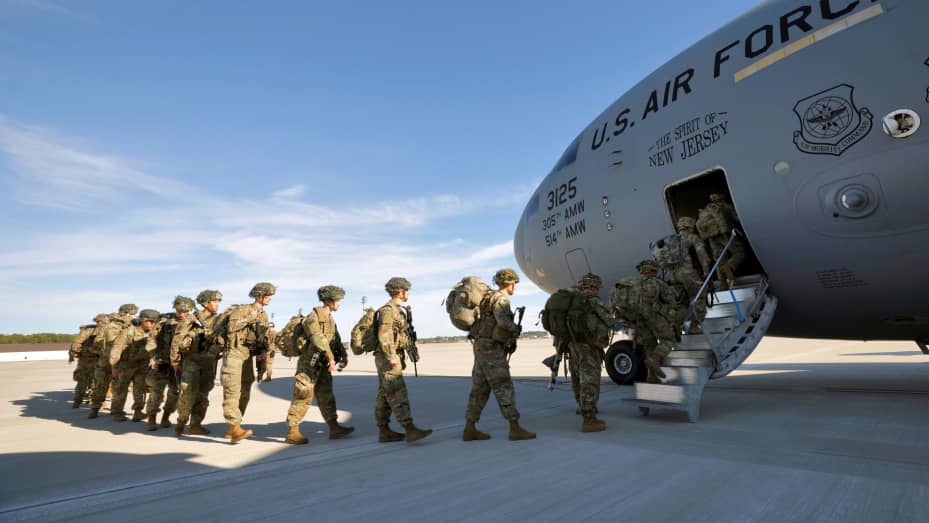MEMBER STATES. NOT THAT YOU WOULD AND/OR WHAT DANGEROUS IS AS OBAMA USED IN HIS RETHORICS, BUT YOU ALREADY HAVE CAUSED A MAJOR IMPACT ON GLOBAL SECURITY DESTABILIZATION.
- The decision fulfills Trump’s announced desire to withdraw troops from Germany, at least in part due to its failure to spend enough on defense.
- U.S. officials said that some moves will begin in months, and would likely send air and ground forces to countries that already have an American troop presence.
- The plan leaves about 25,000 troops in Germany.
PUBLISHED WED, JUL 29 20209:15 AM EDTUPDATED WED, JUL 29 202010:44 AM EDT

Amanda Macias@AMANDA_M_MACIAS

WASHINGTON — Spurred on by President Donald Trump’s demand to pull troops out of Germany, the U.S. will bring about 6,400 forces home and shift about 5,400 to other countries in Europe, U.S. defense officials said Wednesday, detailing a Pentagon plan that will cost billions of dollars and take years to complete.
“The current EUCOM plan will reposition approximately 11,900 military personnel from Germany, from roughly 36,000 down to 24,000, in a manner that will strengthen NATO, enhance the deterrence of Russia, and meet the other principles I set forth,” Secretary of Defense Mark Esper told reporters, referring to U.S. European Command which oversees U.S. military mission on the continent.
The decision fulfills Trump’s announced desire to withdraw troops from Germany, at least in part due to its failure to spend enough on defense.
Trump has frequently dressed down NATO counterparts and threatened to reduce U.S. military support if allies do not increase spending. Last year while in London, Trump singled out German Chancellor Angela Merkel for not meeting the 2% of GDP spending goal set in 2014.
“So we’re paying 4 to 4.3% when Germany’s paying 1 to 1.2%, at max 1.2%, of a much smaller GDP. That’s not fair,” Trump said in December. According to the NATO figures, the U.S. spends less than Trump noted, 3.42% of GDP on defense, while Germany now spends 1.38%, which is an increase of about 11% from 2018.
Read more: Here’s what each NATO country contributes financially to the world’s strongest military alliance
The announcement is closely tied to the plan to increase the U.S. troop presence in Poland, a shift long-desired by Warsaw and Polish President Andrzej Duda. The officials, who spoke on condition of anonymity to discuss plans not yet announced, said the moves will cost “billions” and require construction at bases in the U.S. to accommodate the additional forces. The officials said that in the future other troops would rotate in and out of Europe.
Members of Trump’s own political party have criticized the troop move as a gift to Russia and a threat to U.S. national security. Twenty-two Republicans on the House Armed Services Committee fired back with a letter to Trump saying a reduced U.S. commitment to Europe’s defense would encourage Russian aggression and opportunism.
It’s also unclear if the plan would survive if Trump is not reelected.
Germany is a hub for U.S. operations in the Middle East and Africa. The decision to keep nearly half the forces in Europe, is a clear move by the Pentagon to assuage allies by avoiding the complete withdrawal of 10,000 troops out of the region. And by spreading forces into the east, it sends a message to Russia that the U.S. is not reducing its commitment to region and remains ready to protect Eastern Europe from any Moscow aggression.
Sen. Jim Inhofe, the Republican chairman of the Senate Armed Services Committee, has voiced support for the plan, while also acknowledging it will take “months to plan, and years to execute.” He was briefed on the issue last week, and issued a statement saying the “concept for realigning U.S. military posture in Europe” is sound.
Last month, senior administration officials discussed Duda’s visit to the White House, the first by a foreign leader since the start of the coronavirus pandemic. The White House officials would not offer details of the partial withdrawal of U.S. forces from Germany and would not discuss the possibility that service members could potentially be relocated to Poland.
Instead, the officials touted Warsaw’s financial commitments to NATO as well as the approximately $16 billion in foreign military sales, which includes the U.S.′ most expensive weapons system, the F-35 Lightning II fighter.
The administration officials also volleyed questions on the matter to White House National Security Adviser Robert O’Brien’s op-ed in The Wall Street Journal.
“The Cold War practice of garrisoning large numbers of troops with their families on massive bases in places like Germany is now, in part, obsolete. Modern warfare is increasingly expeditionary and requires platforms with extended range, flexibility and endurance. While air bases and logistics hubs remain important, the Cold War-style garrisoning of troops makes less military and fiscal sense than it did in the 1970s,” O’Brien wrote in an op-ed published on June 21.
He added that the 25,000 U.S. troops slated to remain in Germany still represents a “strong” commitment to Germany by the United States.
The Associated Press contributed to this report.

.png)
.png)
.png)
No comments:
Post a Comment